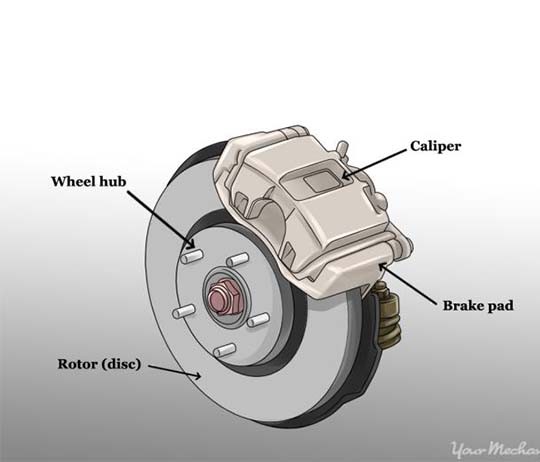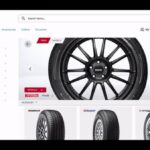Driving safely relies heavily on a well-functioning brake system. As a car owner, understanding the different Parts Of Car Brake is not just beneficial—it’s essential for your safety and wallet. This guide will break down the components of your vehicle’s braking system, explaining their roles and why knowing them is crucial.
Why should you, as a driver, understand the components of your car’s brake system, even if you’re not a mechanic?
Firstly, knowledge empowers you. Understanding how your brake system works gives you a better sense of your car’s overall operation and responsiveness.
Secondly, it has financial benefits. Being familiar with the parts of car brake allows you to have informed conversations with mechanics, understand repair estimates, and prevent being overcharged for replacements or repairs. You’ll be able to identify potential issues early on and address them before they escalate into costly problems.
In this comprehensive guide, we will explore the major components of a car’s brake system, covering both disc and drum brake systems, and essential hardware.
Chapter 1: Exploring the Components of a Disc Brake System
Disc brakes are a common type of braking system in most modern vehicles, particularly on the front wheels. They offer efficient and reliable stopping power. Here are the key parts of a car brake disc system you need to be aware of:
– Brake Pads
Brake pads are a critical wear item in your brake system. These components are essentially friction blocks designed to press against the brake rotor. This friction converts kinetic energy into thermal energy, slowing down or stopping your vehicle’s wheels from rotating.
Brake pads are designed with friction linings that are riveted or bonded to a metal backing plate. This construction is crucial for generating the high friction needed to effectively stop a vehicle. Brake pads and rotors are designed to work in tandem, and their effectiveness is directly linked to their condition.
Over time, the friction material on brake pads wears down due to repeated use and heat exposure. This is why regular brake pad replacement is a necessary part of vehicle maintenance. It’s also important to note that brake pads come in various types, differing in the materials used in their construction, each offering different performance characteristics and wear rates.
– Brake Rotor
The brake rotor, sometimes referred to as a brake disc, is another fundamental part of car brake disc systems. It provides the crucial surface against which the brake pads apply pressure. The rotor is a rotating component, directly connected to the wheel hub.
When you apply the brakes, the brake pads are forced against the rotor surfaces, creating friction and slowing the rotor—and consequently, the wheel—down. Like brake pads, brake rotors are subject to wear and tear. Repeated friction and heat cycles can cause rotors to wear down, warp, or develop grooves.
Brake rotors have a minimum thickness specification. Once a rotor reaches or falls below this minimum thickness due to wear, it must be replaced. Consulting a reliable brake rotor manufacturer or a qualified mechanic ensures you get quality replacements that meet safety standards.
– Brake Caliper
Brake calipers are essential parts of car brake systems responsible for the precise operation of the brake pads. The caliper’s primary function is to house the brake pads and control their movement. When you press the brake pedal, the caliper applies hydraulic pressure to push the brake pads against the rotor. When you release the brake pedal, the caliper releases the pressure, allowing the pads to move away from the rotor.
There are two main types of brake calipers: fixed calipers and floating calipers. Fixed calipers are mounted rigidly and use pistons on both sides of the rotor to apply pressure. Floating calipers, more common in passenger vehicles, are mounted on pins and use pistons on only one side; the caliper itself moves to apply pressure evenly.
Brake calipers, while durable, can also experience issues. One common problem is brake fluid leaks. If you notice signs of brake fluid leakage around the calipers, it’s crucial to have them inspected and repaired or replaced promptly to maintain brake system integrity.
Chapter 2: Understanding the Components of a Drum Brake System
While disc brakes are dominant in the front, drum brakes are still utilized in many modern vehicles, often on the rear wheels. Drum brakes are a cost-effective and reliable braking solution, particularly for the rear axles which typically handle less braking force than the front. Let’s examine the main parts of a car brake drum system:
– Brake Shoes
Brake shoes in a drum brake system serve a similar purpose to brake pads in a disc system. They are the friction components that press against the brake drum to generate stopping force.
Brake shoes are curved metal pieces lined with a friction material, known as the brake lining. This lining is designed to create friction when it contacts the rotating brake drum. Like brake pads, brake shoes are subject to wear over time as the friction material gradually wears away with use.
Regular inspection of brake shoes is essential, and replacement is necessary when the linings become worn down to a critical thickness.
– Brake Drum
The brake drum is a cylindrical metal component that rotates along with the wheel. It acts as the counterpart to the brake shoes in a drum brake system.
The inner surface of the brake drum is the contact point for the brake shoes. When the brakes are applied, the brake shoes are forced outwards against the inner surface of the drum, creating friction. This friction slows down the drum and, consequently, the wheel to which it is connected.
Brake drums are also susceptible to wear and tear. Over time, they can become warped, scored, or develop an out-of-round condition due to heat and friction. Warped or damaged brake drums can reduce braking efficiency and may cause vibrations or noise. When brake drums are warped or exceed their maximum diameter specification due to wear, replacement becomes necessary.
– Backing Plate
The backing plate is a foundational part of car brake drum systems. It is a stationary plate that provides a mounting point for all other drum brake components.
The backing plate essentially holds the entire drum brake assembly together. It supports the brake shoes, wheel cylinder, springs, and other brake hardware within the drum brake system.
Chapter 3: Essential Brake System Hardware and Accessories
Beyond the core components of disc and drum brakes, several other parts of car brake systems are crucial for proper function and performance. These hardware and accessories ensure the system operates smoothly and safely:
– Return Springs
Return springs are specific to drum brake systems. Their function is to retract the brake shoes away from the brake drum when the brake pedal is released.
When you release the brake pedal, return springs exert force to pull the brake shoes back to their resting position, creating clearance between the shoes and the drum. This ensures that the brakes are not dragging when not in use, which could lead to overheating, reduced fuel efficiency, and premature wear.
– Wheel Cylinder
The wheel cylinder is another key component found in drum brake systems. It is a hydraulic actuator responsible for converting hydraulic pressure from the master cylinder into mechanical force to apply the brakes.
Inside the wheel cylinder are pistons that, when hydraulic pressure is applied, move outwards. These pistons push the brake shoes against the brake drum. Wheel cylinders are exposed to brake fluid and pressure, and over time, seals can wear out, leading to leaks. A leaking wheel cylinder can significantly impair braking performance and requires immediate replacement.
– Anti-Lock Braking System (ABS)
The Anti-lock Braking System (ABS) is a critical safety accessory in modern vehicles. While not a direct part of car brake application itself, ABS significantly enhances brake system functionality and safety.
ABS is designed to prevent wheel lock-up during hard braking or on slippery surfaces. By preventing wheel lock, ABS allows the driver to maintain steering control during emergency braking situations and reduces stopping distances, especially in adverse conditions. ABS works by monitoring wheel speed and modulating brake pressure at individual wheels to prevent them from locking up.
Chapter 4: Types of Brake Systems: A Systemic View
Understanding the difference between a brake component and a brake system is crucial. “Brake system” often refers to the overall method of braking, while “brake components” are the physical parts of car brake assemblies.
Brake systems can be categorized by their operating principles:
- Electromagnetic Braking System: Utilizes electric motors and magnetic force to provide braking. Commonly found in electric vehicles and some hybrid systems for regenerative braking.
- Hydraulic Brake System: The most common type in modern cars, using hydraulic fluid pressure to transmit force from the brake pedal to the brake components at the wheels.
- Mechanical Brake System: Relies on mechanical linkages, such as cables and rods, to transmit braking force. Less common in modern cars for primary braking but used in parking brakes.
- Servo Brake System (Vacuum Assisted Braking): Enhances the hydraulic brake system using vacuum pressure from the engine intake manifold to provide power assist, reducing the effort needed to press the brake pedal.
Within these system types, the two primary types of brakes themselves, based on design and construction, are:
- Disc Brakes: Described in Chapter 1. Offer excellent heat dissipation and performance, commonly used on front wheels and increasingly on all wheels.
- Drum Brakes: Described in Chapter 2. Cost-effective and reliable, often used on rear wheels.
Both disc and drum brakes, despite their different designs, operate on the fundamental principle of friction to slow or stop a vehicle. And both types require regular maintenance and replacement of worn parts of car brake to ensure safe and effective braking.
Conclusion
In summary, your car’s brake system is composed of numerous interconnected parts of car brake, each playing a vital role in safely slowing down and stopping your vehicle. Most standard cars utilize a combination of front disc brakes, which handle the majority of the braking force, and rear brakes, which may be either disc or drum type.
By gaining a solid understanding of the components of the brake system, you are better equipped to recognize potential issues and communicate effectively with automotive professionals when maintenance or repairs are needed. Whether it’s brake pads, rotors, shoes, drums, or any other parts of car brake, knowing their function and importance contributes significantly to vehicle safety and informed car ownership. Understanding these components empowers you to ensure your braking system remains in top condition, contributing to safer driving for you and others on the road.

